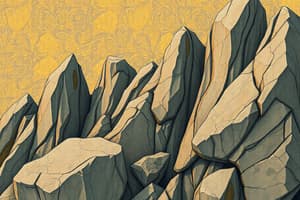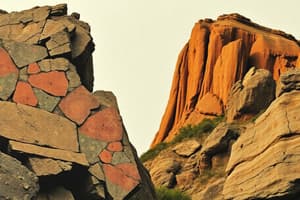Podcast
Questions and Answers
Which process is responsible for the transformation of loose sediments into solid rock?
Which process is responsible for the transformation of loose sediments into solid rock?
- Diagenese (correct)
- Erosion
- Melting
- Metamorfose
What is the primary characteristic of extrusive rocks related to their crystal formation?
What is the primary characteristic of extrusive rocks related to their crystal formation?
- Variable crystal sizes depending on magma composition
- Large, well-formed crystals due to slow cooling
- Medium-sized crystals due to moderate cooling
- No crystal formation due to rapid cooling (correct)
Which factor primarily determines the classification of sedimentary rocks?
Which factor primarily determines the classification of sedimentary rocks?
- The presence of gas bubbles
- The size and type of their constituent grains (correct)
- The temperature and pressure of formation
- The depth at which they are formed
What distinguishes intrusive rocks from extrusive rocks?
What distinguishes intrusive rocks from extrusive rocks?
Which process describes the cycle where rocks are formed, broken down, and reformed?
Which process describes the cycle where rocks are formed, broken down, and reformed?
What is the defining characteristic of pyroclastic rocks?
What is the defining characteristic of pyroclastic rocks?
How does the cooling rate of magma affect the crystal size in intrusive rocks?
How does the cooling rate of magma affect the crystal size in intrusive rocks?
What role do cementation and compaction play in the formation of sedimentary rocks?
What role do cementation and compaction play in the formation of sedimentary rocks?
Which of the following minerals is known as the hardest?
Which of the following minerals is known as the hardest?
What is the primary factor that transforms existing rocks into metamorphic rocks?
What is the primary factor that transforms existing rocks into metamorphic rocks?
Flashcards
Mineral
Mineral
Solid substances made of one or more chemical elements with specific properties like crystal form, density, hardness, color and shine.
Metamorfose
Metamorfose
Rock transformation due to high pressure and temperature. Rock melts back into magma
Rock cycle
Rock cycle
The continuous process of rocks changing form through melting, cooling, weathering, and reforming.
Stollingsgesteenten
Stollingsgesteenten
Signup and view all the flashcards
Pyroclastic Rocks
Pyroclastic Rocks
Signup and view all the flashcards
Intrusive Rocks
Intrusive Rocks
Signup and view all the flashcards
Detritische gesteente
Detritische gesteente
Signup and view all the flashcards
Diagenese
Diagenese
Signup and view all the flashcards
Chemische en biogene gesteente
Chemische en biogene gesteente
Signup and view all the flashcards
Erosie en sedimentatie
Erosie en sedimentatie
Signup and view all the flashcards
Study Notes
- How are the various rocks formed?
Minerals
- All rocks consist of minerals, which are solid.
- They are composed of one or more chemical elements.
- Properties include crystal form, density, hardness, gloss and color.
- Quartz is the most common in the earth's crust.
- Talc is the softest mineral.
- Diamond is the hardest mineral.
Rocks
- Rocks originate and change through various processes, starting with solidified lava.
- Weathering breaks rocks into small pieces called sediments.
- Water, ice, and wind transport these pieces, known as erosion and sedimentation.
- Loose pieces are compressed into new rock, called diagenesis.
- Cementation (gluing together) and compaction (compressing) play a role.
- Metamorphosis occurs when rock changes due to high pressure and temperature.
- Rocks can melt into magma.
- This entire process repeats, and is called the rock cycle.
- Rocks can be categorized based on their genesis.
Magmatic Rocks
- Magmatic rocks originate from the cooling and solidification of magma.
- They occur at various depths and have different subtypes.
- They can be extrusive or intrusive.
Extrusive Rocks
- An alternate term is effusive rocks.
- They originate on the earth's surface.
- Rapid lava solidification prevents crystal formation.
- Gas bubbles in solidifying magma create cavities in the rock.
- Basalt is fine-grained and dark.
- Obsidian is glassy.
- Rhyolite is light colored and contains a lot of silica (grains).
Pyroclastic Rocks
- Pyroclastic rocks consists of fragments from the volcano itself.
- These include fine, large, and small fragments.
- During an eruption, fragments are flung through the air and land on the earth's surface.
- Volcanic ash consists of particles smaller than 2 mm.
- Lapilli consist of particles between 2-64 mm.
- Volcanic bombs consist of particles larger than 64 mm.
Intrusive Rocks
- These rocks form in the earth's crust.
- Because the earth's internal temperature is so high, magma solidifies very slowly.
- This allows larger crystals to form.
- Larger crystals indicate slower solidification at a deeper level.
- Granite, a plutonic rock, has large crystals.
- Porphyry, a dike rock, has smaller crystals.
Sedimentary Rocks
- Another term is deposits.
- They are classified based on the mode of formation.
Detrital Rock
- Detrital rocks originate from the weathering and erosion of other rocks.
- Carried substances in water crystallize between grains.
- Individual particles can cement together to form solid rocks.
- Loose detrital rocks include gravel which is larger than 2 mm.
- Sand consists of particles ranging between 2 mm and 63 mm.
- Loam consists of particles that measure 63-2mm.
- Clay consists of particles smaller than 2 mm .
- Solid detrital rocks include conglomerate, which contains large rock fragments in a matrix.
- Sandstone grains are palpable and visible.
- Siltstone is hard to distinguish from shale.
- Shale grains are not visible to the naked eye.
Chemical and Biogenic/ Organic Rocks
- These are made up of other chemical elements.
- Chemical rocks are formed by crystallization of dissolved substances in water, such as stalactites in caves.
- They are formed from plant or animal remains.
- Carbonates (CaCO3) such as Limestone are made up of skeletons of sea lilies, corals.
- Dolomite can appear grainy by processing.
- Chalk is made up of coccolithophore skeletons and is very soft.
- Silex (SIO2) is made up of skeletons of radiolarian sponges spicules.
- Peat-lignite-coal is made up of plant material, especially marsh vegetation.
Chemical Rocks
- Evaporites
- Halite (rock salt) components precipitate directly in water upon evaporation, tastes salty.
- Gypsum components precipitate directly in water.
Metamorphic Rocks
- Metamorphic rocks arise from rock that changes due to increased pressure and temperature.
- This process is called metamorphism.
- For example, Gneiss forms from granite while bands are visible.
Studying That Suits You
Use AI to generate personalized quizzes and flashcards to suit your learning preferences.




